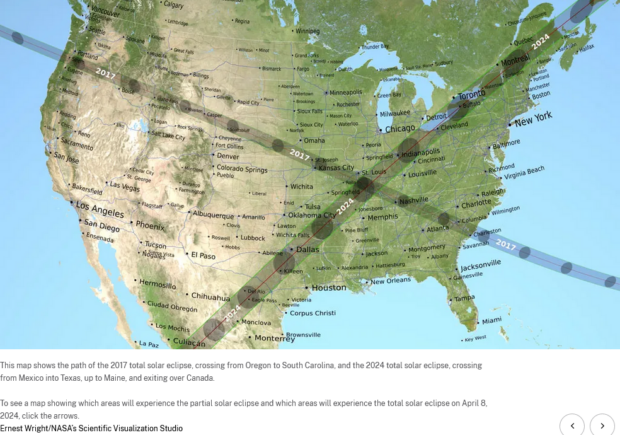Today’s solar eclipse is a reminder that as the sky darkens, road safety remains paramount, according to Penske Transportation Solutions.
Many road safety agencies, including AAA and NHTSA, are reminding drivers to keep their eyes on the road and to not try and view the eclipse while they are behind the wheel.
The total solar eclipse is expected to cross North America, passing over Mexico, the United States and Canada, according to NASA.
The last total eclipse visible in the U.S. was in 2017.
“A total solar eclipse happens when the Moon passes between the Sun and Earth, completely blocking the face of the Sun,” NASA stated.
Weather permitting, the first location in continental North America that will experience totality is Mexico’s Pacific coast at around 11:07 a.m. PDT.
The eclipse path continues from Mexico, entering the United States in Texas, and traveling through Oklahoma, Arkansas, Missouri, Illinois, Kentucky, Indiana, Ohio, Pennsylvania, New York, Vermont, New Hampshire and Maine, according to NASA. The eclipse will enter Canada in Southern Ontario, and continue through Quebec, New Brunswick, Prince Edward Island, and Nova Scotia. The eclipse will exit continental North America on the Atlantic coast of Newfoundland, Canada, at 5:16 p.m. NDT.
The next solar eclipse visible in the U.S. will be August 23, 2044.
To view the eclipse, the American Academy of Ophthalmology suggests wearing special eclipse glasses with certified solar filters, making a pinhole viewer to watch the eclipse indirectly or viewing a live stream of the eclipse.
AAA offers tips for driving during the eclipse:
- Keep headlights on.
- Put the sun visor down to block your view of the sun.
- Don’t wear eclipse glasses while driving.
- Don’t try to photograph or video the eclipse while driving.
- Don’t pull over to the side of the road, highway or interstate to view the eclipse.
- Exit the roadway and park in a safe area away from traffic to view the eclipse.
- Be mindful of pedestrians who may be walking around with their eyes on the sky.





















 What to Expect in 2026: U.S. P/C Results More Like 2024
What to Expect in 2026: U.S. P/C Results More Like 2024  Berkshire Hathaway Announces Leadership Appointments: New CEO at GEICO
Berkshire Hathaway Announces Leadership Appointments: New CEO at GEICO  Police Recover Swallowed Fabergé Pendant 6 Days After it Was Stolen
Police Recover Swallowed Fabergé Pendant 6 Days After it Was Stolen  U.S. E&S Outlook No Longer Positive: AM Best
U.S. E&S Outlook No Longer Positive: AM Best 




